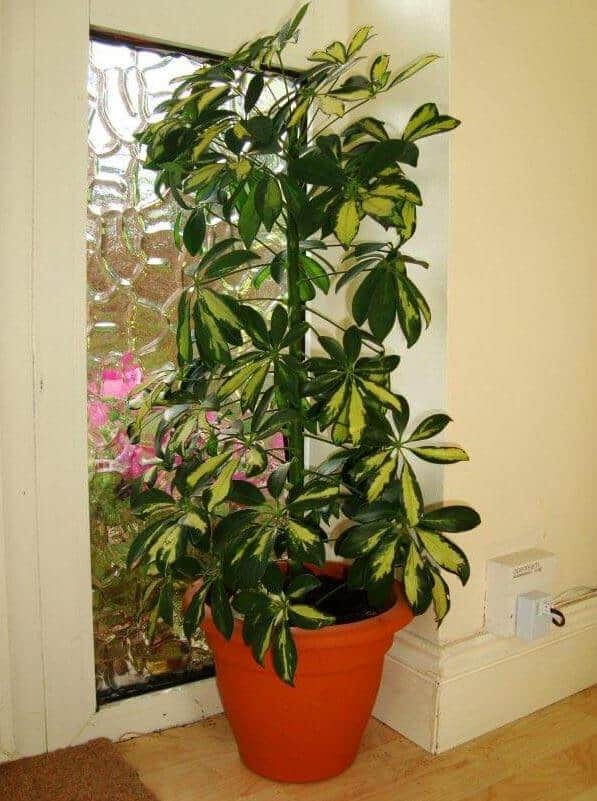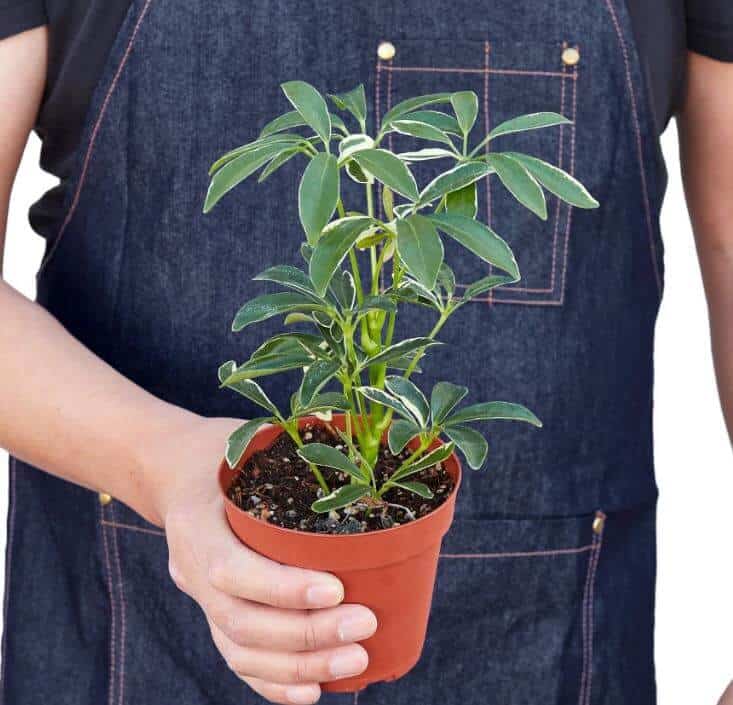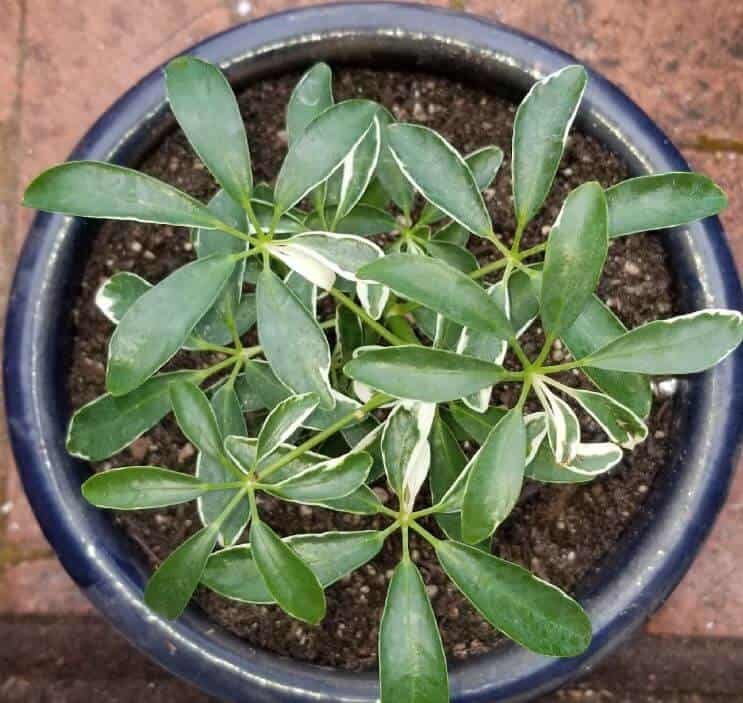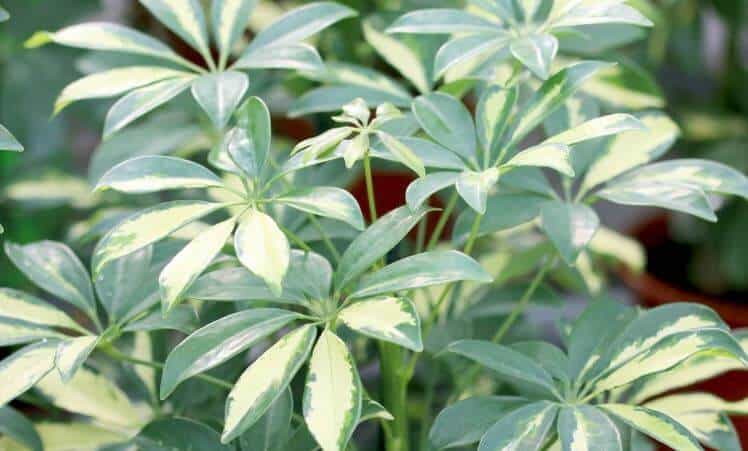Last Updated on September 9, 2023 by a Friendly Gardener
Boasting a rather poetic common name, the Schefflera arboricola “Moondrop” hails from Southeast Asia yet is a very popular houseplant in cooler climates. Also referred to as the Dwarf Umbrella Tree “Moondrop”, this delightful evergreen shrub belongs to the Araliaceae family. It features smaller, glossy palmate leaves and small flower umbels.
When cultivated outdoors, the plant has a rapid growth habit while indoor specimens will have a slower growth rate. The Moondrop plant size varies depending on cultivation location. As an indoor plant, your Moondrop plant can reach four to six feet in height and three to six feet in width. In an outdoor garden, these plants can reach as high as twenty-five feet.
When well-cared for, Schefflera houseplants have been known to live for twenty-five years and longer. Outside in the correct climate, they can live for decades.
Moondrop Plant Care

The Moondrop plant should only be cultivated outdoors if environmental temperatures remain above 55°F or in USDA hardy zones 10 through 12, otherwise, it can be cultivated in your indoor garden. These plants are not overly demanding or difficult to grow. Generous indirect light, a warm environment, and a bit of humidity are all they require. Bright light and proper watering are the two most important care considerations that you will need to implement.
If you wish to plant this Umbrella tree, it can be planted from early spring right through to late winter. If your climate is warm, try to plant in the spring or autumn when the temperatures are more temperate. Indoor plants produce flowers only rarely.
Soil
Fertile, loose potting soil that drains well is ideal. Outside garden soil should be loamy sandy soil to guarantee drainage. Wet or heavy clay soils are not recommended for the cultivation of Moondrop plants. Soil pH needs to be slightly acidic measuring between 6 and 6.5.
Light

Light is essential for a Moondrop plant to thrive. Without generous sunlight, your umbrella tree will drop its leaves. However, these plants should not be placed in direct sunlight as this may burn tender foliage. Bright, indirect light near a window should encourage growth. If your plant develops a leggy appearance or begins to flop, light may be insufficient, and you should consider moving your plant to a sunnier spot.
Water
During the growing season, this Schefflera needs frequent waterings and the frequent misting of leaves. Allow the soil to dry out and then soak your plant. Reduce water in the winter. Overwatering is fatal to Moondrop plants and leaf drop or yellowing foliage are generally symptoms.
Humidity
Humidity should be on the higher side as the Moondrop loves a humid environment. If your indoor air is dry, consider using a space humidifier or a pebble tray underneath your plant’s container. Mist foliage frequently.
Temperature
The Moondrop plant needs tropical temperatures so indoor temps are usually fine as long as they do not drop below 60°F. Moondrop plants should be protected from drafts and positioned away from air conditioning or heating units and vents. Schefflera that are cold will drop foliage very quickly.
Feeding

During the growing season, your plant will benefit from fertilizing twice weekly. Use a balanced liquid houseplant fertilizer. Moodrop plants are heavy feeders, so the extra nutrients will serve them well.
Pruning
The Schefflera arboricola may need occasional trimming. Should it become leggy due to insufficient light, prune leggy stems. As a rapid grower, your plant will develop a bushier, fuller appearance with pruning. When pruning, wear gloves to avoid contact with this plant’s sap which will irritate the skin.
Repotting a Schefflera Arboricola Moondrop

Plan on repotting your Moondrop plant annually. Depending on the rate of growth you may need to do so earlier if your plant outgrows its container. Allowing these plants to become somewhat rootbound will slow their growth rate. Opt for a clay or terracotta pot that is larger and has sufficient drainage holes. Clay pots will help wick away excess moisture. When repotting, it is recommended that you wear gardening gloves to prevent possible skin irritation.
Moondrop Plant Propagation

Moondrop plants are best propagated using stem cuttings. Trim your plant in the spring and use cuttings for propagation efforts.
- Trim a six-inch stem section at a 45° angle. Remove all but the top four to six leaves.
- Dip the cut end of the stem section in a rooting hormone.
- Place the cut end in a container with quality potting soil and loosely cover the cutting with plastic.
- Position the cutting in bright indirect light in a warm spot.
- Check daily to ensure that the soil bed remains slightly moist.
- Roots should develop after approximately a month. If they do not, you should discard your cutting and attempt again using a new cutting.
Moondrop Plant Problems
Schefflera plants are susceptible to Alternaria Leaf Spot and Bacterial Leaf Spot infections. To prevent these diseases, avoid evening watering and overhead watering. Should they appear despite good watering practices, apply a fungicide that is copper-based.
When cultivated indoors, aphids can be a problem. These pests will leave a sticky honeydew secretion on foliage. The honeydew will eventually lead to sooty mold. Remove affected leaves and treat your plant with insecticidal soap or neem oil. Also, be on the lookout for scales, spider mites, and mealybugs. You can use a water spray to remove pests and then proceed to treat them with insecticidal soap or neem oil.
Yellowing foliage can indicate overwatering or inadequate light. Check the soil for sogginess or move your plant to a brighter location. Brown spots on foliage generally indicate underwatering.
Indoor plants will accumulate dust on the foliage which can render photosynthesis difficult and harm your Moondrop plant. Once a month and gently wipe foliage to remove any dust.
Schefflera Arboricola Moondrop Toxicity
In the case of the Moondrop plant cats and dogs should not have access. All parts of your Moondrop plant are toxic to family pets and horses, and mildly toxic for human beings as well. The Moondrop plant contains lots of calcium oxalate crystals. Sap will irritate the skin, and ingestion of plant parts will cause nausea. Keep your Moondrop out of the reach of children and fur babies.

